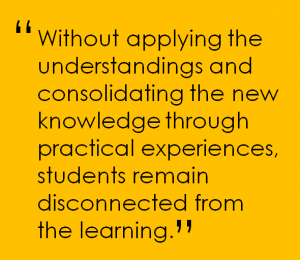The IB encourages teachers to facilitate learning, versus "teaching" students. In a PYP classroom a teacher's role is more about guiding learning, supporting ideas and helping students make connections. It is much less us as adults imparting what we "know" to students so that they can "remember" it. We want our students to construct their own knowledge, because this is how they learn best. We want them to build off of what they already know, adding news ideas, thoughts and concepts to their already established experiences and understandings. This constructivist approach is guided by inquiry. This type of learning goes beyond the basic level of learning (which is simply acquiring knowledge). We ask them to be able to interact with these new ideas using higher level/critical thinking skills such as apply, analyze, synthesize and evaluate (the PYP thinking skills). This relates directly to the idea that we want to focus on what is relevant, and worth knowing. One way we guide this learning is by using INQUIRY. Inquiry is a collaborative way of learning that gives kids the opportunities to engage in experiences that challenge their thinking and build on what they already know and can do. Here is an example of an inquiry cycle that we often use to organize those experiences:

This image was created by John Crawford in conjunction with Elizabeth Crawford for U.S. Fund for UNICEF curriculum.
Students do learn and grow at every step along the way, the goal of our learning is to use it, to take ACTION. Tuning in is where we establish the value in what we are exploring, and provoke new ideas by discussing what we know and how. We then engage students in a variety of learning experiences to tune in to the idea and begin to establish our thoughts and some connections. We sort out our learning by sharing and collaborating and can then learn from each other. This motivates us to ask questions and go deeper, based on what we now know we can ask WHY regarding more specific aspects of the inquiry-the students then go further. Towards the end of our inquiry we can draw conclusions and begin to alter our choices and behavior in ways that constitute ACTION. At this point students who are still really engaged in this idea can continue their learning at any point in the cycle again.
This is a loose, fluid approach that allows for all types of learners to go at their own pace and pause and investigate what they want to know. It also encourages us to use each other as a resource along the way. We cannot learn in isolation.
Tune in to learn more about how our 5th grade students are using this approach for their Exhibition.
:

 During 2nd grade's How We Organize Ourselves Unit, students examine the economy and its components. One of the things they explore is the relationship between work and personal, financial and societal needs. In order to experience the laws of supply and demand and investigate the role of taxes in our society, students create products to market and sell to their peers. Some of the resulting earnings are then paid as classroom taxes and the "citizens" have input on how they are spent. It is a wonderful way for kids to synthesize their learning through role play and experience!
During 2nd grade's How We Organize Ourselves Unit, students examine the economy and its components. One of the things they explore is the relationship between work and personal, financial and societal needs. In order to experience the laws of supply and demand and investigate the role of taxes in our society, students create products to market and sell to their peers. Some of the resulting earnings are then paid as classroom taxes and the "citizens" have input on how they are spent. It is a wonderful way for kids to synthesize their learning through role play and experience!








- Follow Us on Twitter!
- "Join Us on Facebook!
- RSS
Contact